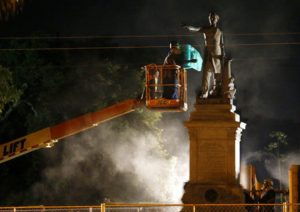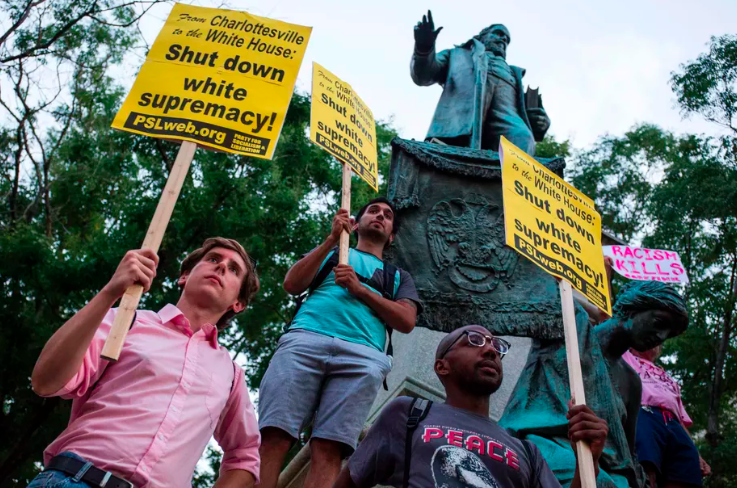 Counter-protests after the Charlottesville protests that erupted over the weekend. [Image: Zach gibson/Getty Image]
Counter-protests after the Charlottesville protests that erupted over the weekend. [Image: Zach gibson/Getty Image]
At the most recent violent gathering in Charlottesville, questions are being raised over the legitimacy of commemorating Confederate soldiers with monuments and statues. In the past Confederate symbols have become a rallying point for many white supremacist groups and sympathisers who oppose, among other things, the removal of these monuments.
Since April of 2016 only nine Confederate statues across the United States have been removed because there’s a long political process before it can be done.
According to the Southern Poverty Law Centre, 718 Confederate monuments and statues remain, with nearly 300 of them residing in Georgia, Virginia and North Carolina. The number of Confederate commemorative monuments across 31 US states is estimated to reach the thousands, with public parks, squares, schools and courthouses having been named after Confederates.
In this increasingly fraught political environment, we look into the men of the emboldened busts as a reminder of what was once fought and overcome in the dark history of our country’s closest ally.
Background
In 1860 Abraham Lincoln won the election. Threatened by the prospect of freed slaves and the national government prohibiting slavery, Confederate sympathisers and Southern states seceded from the Union.
Consequently, the Civil war began in 1861, with the Confederate army (the army of the Confederate States of America during the Civil war) taking up arms against the Union Army.
1. Major John (‘The Gallant’) Pelham

Monument of Confederate Major at Jacksonville City Cemetery. A monument also stands in the town of Brandy Station, Virginia.
One of the son’s of an Alabama planter, Pelham’s father had several hundred acres of land and owned four slaves at the time of Pelham’s birth. By the time of the Emancipation Proclamation, Dr. Pelham owned around 30 slaves.
Pelham quit school at West point in 1861, to join the Confederacy. This came after Secretary of War Simon Cameron, directed that all West Point cadets pledge their allegiance to the United States of America.
Pelham refused and headed south.
He wrote of the war: “I see the horrors of war, but it’s necessary: We are battling for our rights and our homes. Ours is a just war, a holy cause. The invader must meet the fate he deserves and we must meet him as becomes us, as becomes men.”
Confederate Major Pelham was killed in a cavalry charge at the Battle of Kelly’s Ford.
2. Confederate President Jefferson Davis

Statue of Confederate President Jefferson Davis on Monument Avenue in Richmond, Virginia. As well as this statue, there are Jefferson Davis Memorial’s in both Georgia and Kentucky. [Image: Phil Riggan].
Jefferson Davis statue in New Orleans.

The statue was removed earlier this year under heavy police guard. [Image: Associated Press].
Jefferson Davis was the son of Samuel Emory Davis, owner of Rosemont at Woodville plantation in Mississippi. Davis himself became a planter in 1835, before being elected to the US House of Representatives.
Davis was in favour of the Dred Scott decision, which was handed down by Chief Justice Taney and strongly denounced those who opposed it.
“Instead of accepting the decision of this then august tribunal—the ultimate authority in the interpretation of constitutional questions—as conclusive of a controversy that had so long disturbed the peace and was threatening the perpetuity of the Union, it was flouted, denounced, and utterly disregarded by the Northern agitators, and served only to stimulate the intensity of their sectional hostility.”
In 1861, Davis resigned from the US House of Representatives and after his farewell speech to the US Senate he was chosen as the President of the Confederacy.
In his farewell address to the Senate Chamber in January of 1861 he wrote in defence of slavery, as well as stating the cause of his states secession: “She had heard proclaimed the theory that all men are created free and equal, and this made the basis of an attack upon her social institutions; and the sacred Declaration of Independence has been invoked to maintain the position of the equality of the races.”
In his memoirs published in 1881, he wrote: “As a mere historical fact, we have seen that African servitude among us ―confessedly the mildest and most humane of all institutions to which the name “slavery” has ever been applied―existed in all the original states, and that it was recognised and protected in the fourth article of the Constitution.”
For the most part, Davis held morally reprehensible views on slavery, having also written: “African slavery, as it exists in the United States, is a moral, a social, and a political blessing.”
“If slavery be a sin, it is not yours. It does not rest on your action for its origin, on your consent for its existence. It is a common law right to property in the service of man; its origin was Divine decree.”
3. John C. Breckinridge

Monument of John C. Breckinridge in Lexington, Kentucky.
It was only recently that Lexington Mayor, Jim Gray spoke of relocating the Confederate monument of Breckinridge, in addition to the monument of John Hunt Morgan.
Mayor Gray referenced the violence in Charlottesville as having led him to announce the plans, telling CBS News, “Mayors are on the razor’s edge. When you see the tension, when you see the violence that we saw… in Charlottesville, then you know that we must act.”
John C. Breckinridge was a well known senator from Kentucky. In 1860 he ran as a presidential candidate for the Southern Faction of the Democratic Party, against Abraham Lincoln. He campaigned on a pro-slavery platform, as well as federal intervention to protect slaveholders in the territories; he was also vocal in his support of maintaining the Union’s, despite the developing conflict and Southern secession. Breckinridge lost the presidency to Lincoln and became the 14th Vice President of the United States, having served from 1857 to 1861.
Breckinridge joined the Confederacy in 1861 and served as a Confederate Field General for the most part of the war. In 1865 he was appointed to Confederate Secretary of War.
Breckinridge’s father was a former US Secretary of State and his mother was the granddaughter of John Witherspoon (a signer of the Declaration of Independence).
Breckinridge considered slavery to be a political issue, rather than a moral one. An example of this is his support of the ‘Popular Sovereignty‘ doctrine, a solution coined by Michigan democrat Lewis Cass. The doctrine advocated for the people of territories to decide for themselves whether slavery should or would be permitted.
4. John Hunt Morgan

Statue of Confederate General John Hunt Morgan in Lexington, Kentucky. The statue of John Hunt Morgan has been brought into talks by Lexington Mayor Jim Gray for its relocation.
Known as ‘Thunderbolt of the Confederacy’, Morgan was a hemp manufacturer and a ‘successful’ buyer and seller of slaves in Kentucky.
He established and equipped a militia company called the ‘Lexington Rifles’ and immediately answered the call on behalf of the Southern Confederacy.
Morgan was a prominent Confederate cavalry officer whose story is often romanticised in the South. But the Confederate General died in battle fighting to preserve slavery.
5. Roger B. Taney

The monument of Confederate and former Chief Justice Roger B. Taney presides on the front lawn of the Maryland State House. House speaker Michael E. Busche has announced it’s time to remove the statue of Taney from the Maryland State House grounds.
Roger B. Taney is Maryland’s most prominent Confederate monument.
As the son of Michael Taney, a politician and planter, the Taney family had been slaveholding planters since their first ancestors arrived in Maryland in the 1660s.
In 1835 Taney was nominated to the Supreme Court and in 1857 handed down his 55-page opinion in the infamous Dred Scott v. Sandford case, a decision that kept slavery legal and denied citizenship for black people.
Taney’s opinion stated that Scott was a slave and reiterated the Southern Democratic defence of slaves being kept as property. Taney viewed citizenship as being attached to birth or naturalisation. He concluded that few blacks met this criteria and after the Dred Scott decision, some states passed laws that significantly limited the civil rights of free blacks.
Taney’s opinion in the Dred Scott case supplanted the South’s defence of slavery and forced the divide between the Northern Democrats even further.
6. General ‘Stonewall’ Jackson

The monument of Confederate General Thomas J. ‘Stonewall’ Jackson on Monument Avenue in Richmond, Virginia.
One of the most successful Civil war generals, Jackson seceded from his home state and the Union in 1861 to join the Confederate Army.
Prior to the war he as a professor of artillery tactics and natural philosophy in Lexington. He spread the Gospel to slaves and even held a Sunday school for slaves in his home and then later in the church.
He earn’t the nickname ‘Stonewall’ in 1861 when one of his generals said, “Look, men, there is Jackson standing like a stone wall!”
Jackson joined Robert E. Lee’s army in 1862 and became a key part of his army.
Historians have struggled with making conclusions about Jackson’s moral positioning. It seemed Breckinridge had significant relationships with slave families throughout his upbringing and as a preacher, but he also grappled with Scriptures recording slaveholding across the world. Jackson’s rationale was if the Bible condoned it, it would have to be acceptable.
7. Nathan Bedford Forrest

The odd-looking statue of Confederate General Nathan Bedford Forrest installed on a private property in Nashville, Tennessee.

Monument of General Forrest in a Memphis public park is being considered for removal.
Forrest made his living as a cotton planter and a slave trader. In the years following 1845 Forrest was said to have been one of the richest men in Tennessee because of his dealings in cotton, land and slaves.
During the war, where he was a premier soldier and Lieutenant General for the Confederate army, he was nicknamed the ‘Wizard of the Saddle.’ But after the war he was elected as the first Grand Wizard of the Ku Klux Klan. Although he later left the KKK and renounced his racist past, testifying this before a Joint Congressional Committee in 1871.
In Tennessee’s Capitol, there is a copper bust of Forrest where his role as a Confederate general is noted, although his ties to the KKK are omitted.
8. Robert E. Lee

At the heart of the ‘United the Right’ rally in Charlottesville in Virginia on August 12th, the statue of Robert E. Lee has been considered for removal. [Image: Bryan McKenzie/AP].
An elusive historical figure, Lee inherited slaves from his mother and married into one of the wealthiest slave-holding families in Virginia.
Documents and accounts reveal that Lee was an intentionally cruel slave owner that commonly encourage beatings after slaves tried to escape.
The circulating myths that regarded Lee’s involvement in the Civil war as being for a cause other than the protection to own slaves has been refuted by a number of American history professors who have called it ‘white washing’.
In 1856 Lee wrote in a letter that slavery was: “A moral and political evil.” But much like General ‘Stonewall’ Jackson, Lee still believed that it was God’s divine purpose and therefore opposed human intervention.
Lee also wrote: “The blacks are immeasurably better off here than in Africa, morally, physically, socially. The painful discipline they are undergoing is necessary for their further instruction as a race, and will prepare them, I hope, for better things.”
There are currently 109 public schools named for Robert E. Lee.
There is only one question we should be asking and that is, do we really want to be commemorating these figures with brass and pedestals?







